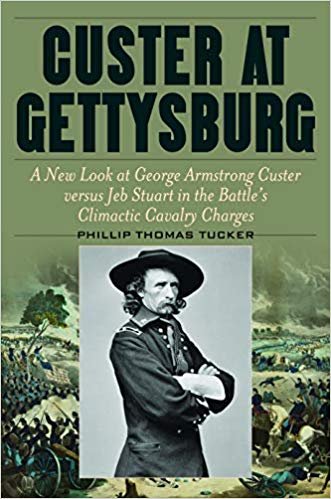George Armstrong Custer is famous for his fatal defeat at the Little Bighorn in 1876, but Custer’s baptism of fire came during the Civil War.
After graduating last in the West Point class of 1861, Custer served from the First Battle of Bull Run (only a month after graduation) through Appomattox, where he witnessed the surrender. But Custer’s true rise to prominence began at Gettysburg in 1863.
On the eve of the Battle of Gettysburg, only twenty-three years old and barely two years removed from being the goat of his West Point class, Custer received promotion to brigadier general and command – his first direct field command – of the Michigan Cavalry Brigade, the “Wolverines.”
“A thoughtful and challenging new look at the great assault at Gettysburg, from planning to aftermath. Not afraid to lay blame where he thinks it belongs, Tucker is fresh and bold in his analysis and use of sources. Even though any reader knows in advance the outcome, still Pickett’s Charge maintains suspense to the sound of the last gun.”
—William C. Davis, author of Crucible of Command
Now that he held general rank, Custer felt comfortable wearing the distinctive, some said gaudy, uniform that helped skyrocket him into fame and legend. However flashy he may have been in style, Custer did not disappoint his superiors, who promoted him in a search for more aggressive cavalry officers.
At approximately noon on July 3, 1863, Custer and his men heard enemy cannon fire: Stuart’s signal to Lee that he was ready for action.
Thus began the melee that was East Cavalry Field at Gettysburg. Much back and forth preceded Custer’s career-defining action. An hour or two into the battle, after many of his cavalrymen had been reduced to hand-to-hand infantry-style fighting, Custer ordered a charge of one of his regiments and led it into action himself, screaming one of the battle’s most famous lines: “Come on, you Wolverines!” Around three o’clock, Stuart mounted a final charge, which mowed down Union cavalry – until it ran into Custer’s Wolverines, who stood firm, with Custer wielding a sword at their head, and broke the Confederates’ last attack.
In a book combining two popular subjects, Tucker recounts the story of Custer at Gettysburg with verve, shows how the Custer legend was born on the fields of the war’s most famous battle, and offers eye-opening new perspectives on Gettysburg’s overlooked cavalry battle.
ATTENTION READERS
We See The World From All Sides and Want YOU To Be Fully InformedIn fact, intentional disinformation is a disgraceful scourge in media today. So to assuage any possible errant incorrect information posted herein, we strongly encourage you to seek corroboration from other non-VT sources before forming an educated opinion.
About VT - Policies & Disclosures - Comment Policy






Custer broke the cavalry movement that would have hit the Union rear just as Longstreet’s brigades were hitting its front. It is one of the most remarkable of so many remarkable exploits of that war, that a young cavalryman defeated a rebel host five times the size of his force, and commanded by the best cavalry commander of the south.
Still a southern “victory” there (and it is well-nigh impossible to visualize what such a victory would have looked like) would not have ended the struggle to keep the Union intact. More than half the territory claimed by the insurgents in 1861 was back under national control by the summer of 1863, there was a large and growing counterinsurgency at the south, and there were still another nine hundred thousand men serving in the U.S. army and navy in other theaters of the war.
In any case, an aggressive, expansionist foreign power at its southern border and in control of the Mississippi River would have been an existential threat to the economic survival of the free states and to their evolving popular democracy. The war would have continued to its inescapable conclusion regardless of the outcome of any single engagement.
Comments are closed.